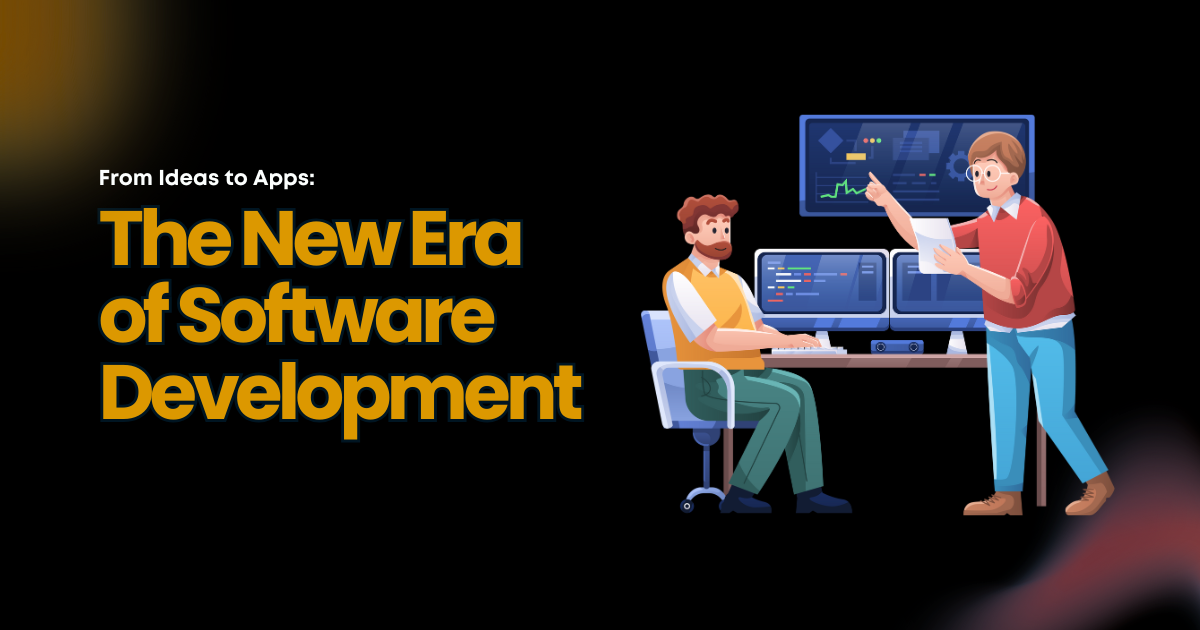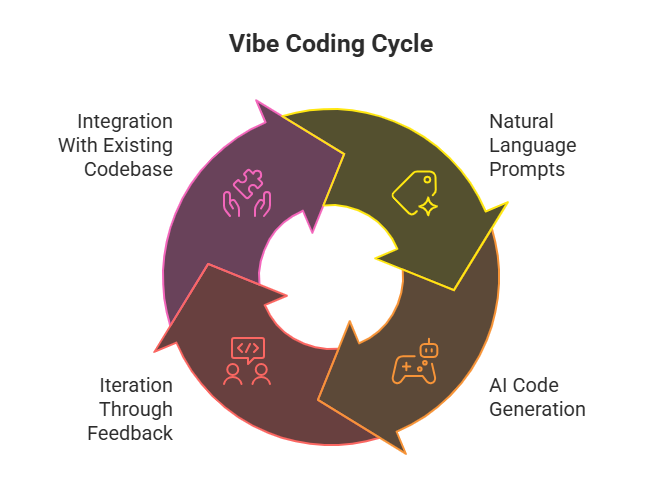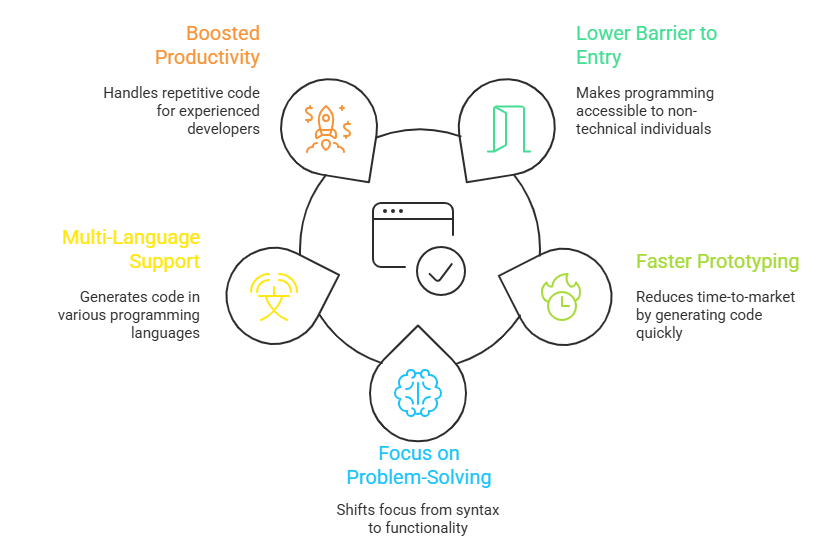
What Is Vibe Coding?
Vibe coding is an AI-driven development style where users write prompts (instructions in everyday language) that describe the functionality or design they want. The AI model then generates the underlying code automatically.
For example:
● Instead of writing 30 lines of JavaScript for a responsive button, you might type: “Create a button that changes color when hovered and triggers an alert on click.”
● For a backend task, you might prompt: “Generate an API endpoint that handles user login with email and password, connected to a MongoDB database.”
In both cases, the AI outputs production-ready code, often in the framework or language you specify (React, Python, Node.js, etc.).
How Vibe Coding Works

1. Natural Language Prompts
The developer begins with a prompt — a sentence or paragraph describing the desired outcome. The more precise the prompt, the better the code generated.
Example:
“Build a React component for a shopping cart that updates in real time when items are added or removed.”
2. AI Code Generation
The AI model (powered by large language models trained on billions of lines of code) interprets the prompt and produces structured code. Depending on the platform, this code can be in multiple languages and frameworks.
3. Iteration Through Feedback
Developers review the generated code and can refine it with additional prompts, such as:
● “Make the cart persist in local storage.”
● “Add a discount calculation for coupon codes.”
4. Integration With Existing Codebase
The generated code isn’t a standalone app. Developers usually merge it into existing projects, tweak it as needed, and use traditional debugging or testing tools to ensure quality.
Benefits of Vibe Coding

1. Lower Barrier to Entry
Vibe coding makes programming more accessible to non-technical people. Entrepreneurs, designers, or product managers can create prototypes without deep coding knowledge.
2. Faster Prototyping
What once took hours or days of manual coding can be generated in minutes. Teams can validate ideas quickly and reduce time-to-market.
3. Focus on Problem-Solving, Not Syntax
Instead of worrying about semicolons or curly brackets, developers focus on describing the functionality they need. This shifts effort toward design, architecture, and user experience.
4. Multi-Language Support
One prompt can generate code in different languages. For example, the same login API could be generated in Python, Node.js, or Go by slightly adjusting the instruction.
5. Boosted Productivity for Experienced Developers
Even seasoned programmers can use vibe coding to handle repetitive or boilerplate code (e.g., database schemas, CRUD operations) and spend more time on complex problem-solving.
Challenges and Limitations
1. Ambiguity in Prompts
Natural language is flexible, but also imprecise. A vague prompt like “Build a secure login system” may generate incomplete or insecure code. Clear, detailed prompts are necessary for good results.
2. Code Quality Concerns
AI-generated code may not always follow best practices. It might be functional but inefficient, insecure, or difficult to maintain. Human review remains essential.
3. Dependency on Tools
Vibe coding relies heavily on AI platforms. If the system goes down, generates errors, or has limitations, development can stall.
4. Security Risks
If developers blindly trust generated code, they risk introducing vulnerabilities. AI might not always handle authentication, encryption, or validation correctly.
5. Reduced Deep Understanding
For beginners, vibe coding can be a double-edged sword. While it lowers the learning curve, it may also discourage learning the fundamentals of programming. Without a basic understanding, debugging or scaling generated code becomes harder.
Vibe Coding vs Traditional Coding
| Aspect | Traditional Coding | Vibe Coding Development |
| Skill Requirement | Requires learning languages, frameworks, and syntax | Requires clear prompt-writing and conceptual clarity |
| Speed | Slower for prototypes, faster for precise tasks | Extremely fast for prototyping, variable for complex tasks |
| Flexibility | Unlimited, but demands expertise | Limited to what the AI model supports |
| Code Ownership | Developer-written and controlled | AI-generated, needs review and modification |
| Best Suited For | Production systems, complex logic | Prototyping, repetitive tasks, idea validation |
As a leading vibe coding development company, EnactOn brings together the best of both worlds — skilled vibe coders who accelerate projects with AI-driven workflows, and traditional developers who ensure stability, scalability, and long-term success. With experience serving 500+ clients across 65+ countries, we help businesses overcome challenges by blending speed with precision.
The Role of Developers in Vibe Coding
Some fear vibe coding could replace programmers. In reality, it reshapes their role:
● Developers act as prompt engineers, learning how to phrase instructions for maximum clarity.
● They serve as reviewers, ensuring generated code meets security, performance, and style standards.
● They remain architects, responsible for overall system design, scalability, and integration.
AI handles repetitive details, while humans focus on higher-level thinking.
Real-World Applications
1. Startup Prototyping
A founder with minimal coding knowledge can quickly generate a working MVP by prompting features like login, payment gateway, or chat support.
2. Internal Tools
Companies often need dashboards or automation tools. With vibe coding, a small team can generate CRUD apps or reports in hours.
3. Education
Students can learn programming concepts faster by prompting and analyzing generated code, rather than writing everything from scratch.
4. Enterprise Development
Large organizations can accelerate development of standard modules (authentication, reporting, notifications) while reserving engineers for advanced tasks.
Top 5 Vibe Coding Tools
1. GitHub Copilot
GitHub Copilot, powered by OpenAI, is used by more than 1.3 million developers worldwide and integrated into 20,000+ organizations. It supports over 50 programming languages and can autocomplete entire functions based on natural language prompts. With its seamless integration into Visual Studio Code, it helps developers cut repetitive coding tasks by up to 40%, making it the most adopted vibe coding tool on the market.
2. Replit
Replit has a community of over 25 million users, and its Ghostwriter feature makes vibe coding accessible to students, startups, and professionals.
The tool supports real-time collaboration and offers 1-click deployment of applications in the browser. Ghostwriter can generate working code snippets in seconds, often reducing prototype build times by 60–70% compared to manual coding.
3. Cursor
Cursor, one of the newer AI-native IDEs, is rapidly gaining traction with tens of thousands of developers adopting it in its first year.
It allows developers to write, refactor, and debug code through conversational prompts and claims productivity improvements of 30–50% in everyday workflows.
Cursor supports multiple languages, offers lightning-fast refactoring, and is optimized for AI-first coding rather than retrofitted into legacy IDEs.
4. Lovable
Lovable is one of the fastest-growing players in the vibe coding ecosystem, attracting over 20,000 early users within months of its launch.
The platform enables founders and developers to build complete applications through natural language prompts, eliminating much of the manual coding process.
In 2025, Lovable secured a $15 million funding round led by Accel, further accelerating its growth. Teams using Lovable report development speed increases of 45–55%, turning ideas into functional prototypes in a matter of days rather than weeks.
5. Bolt.new
Bolt.new has quickly become a preferred vibe coding platform, powering 50,000+ projects across startups and indie developer communities.
Supporting more than 15 programming languages, Bolt.new integrates directly into existing workflows with its AI-assisted generation, refactoring, and debugging features.
Developers report 30–45% productivity gains, especially on repetitive coding tasks, and the platform continues to grow steadily, with thousands of new users signing up every month.
6. Tabnine
Tabnine is trusted by more than 1 million developers and integrates with over 20 IDEs, including JetBrains, VS Code, and Eclipse.
It offers natural language-to-code functionality while maintaining enterprise-level security, with on-premises deployment options that meet GDPR and SOC2 compliance.
Teams using Tabnine report coding task accelerations of around 25–40%, especially for boilerplate-heavy projects.
7. Amazon CodeWhisperer
Amazon CodeWhisperer is tailored for AWS developers and has been shown to speed up cloud-related coding tasks by up to 57%.
It provides real-time code suggestions for services like Lambda, DynamoDB, and S3, and supports multiple programming languages including Python, Java, and JavaScript.
With AWS adoption by over 1 million active customers, CodeWhisperer has quickly become a go-to vibe coding tool for teams building scalable cloud-native applications.
Leading Vibe Coding Development Agencies
1. EnactOn
EnactOn is a trusted vibe coding development company with a strong global presence, having delivered over 500 projects for clients in 65+ countries.
Their strength lies in blending the expertise of traditional developers with the innovation of skilled vibe coders, ensuring projects are not only built quickly but also with long-term reliability in mind.
By combining these two approaches, Enacton operates as a vibe coding agency that provides clients with scalable, efficient, and future-ready solutions tailored to their unique needs.
2. Prismetric
Prismetric positions itself as a vibe coding agency that helps businesses transform ideas into real applications through AI-powered development.
As a vibe coding development company, Prismetric leverages natural language prompts alongside expert oversight to deliver functional software.
Their team of vibe coders focuses on creating efficient solutions while ensuring that the generated code is refined and production-ready.
3. Excellent Webworld
Excellent Webworld is recognized as a vibe coding development company with a focus on rapid prototyping and flexible delivery models.
Acting as a vibe coding agency, they emphasize speed and innovation, enabling clients to test ideas quickly with AI-assisted workflows.
Their vibe coders complement human engineers, providing a balance between experimentation and stability to ensure client projects can move from concept to reality smoothly.
4. SolGuruz
SolGuruz offers services as a vibe coding development company, catering to businesses looking for faster ways to turn ideas into software.
As a vibe coding agency, they highlight their ability to integrate AI-powered code generation with traditional development methods.
Their vibe coders contribute by building prompt-driven features, while experienced engineers oversee performance, scalability, and alignment with client goals.
The Future of Vibe Coding
As models improve, vibe coding may evolve into:
● Full-stack generation: Writing one prompt to build frontend, backend, and database schema in one go.
● Visual prompts: Drag-and-drop wireframes combined with text prompts to generate entire applications.
● Continuous integration: Generated code that automatically comes with unit tests, deployment scripts, and monitoring.
● Collaboration AI: Systems that not only generate code but also explain trade-offs, suggest optimizations, and align with a team’s coding standards.
However, the human role will remain critical. No matter how advanced AI becomes, developers will be needed to define problems, validate solutions, and ensure long-term quality.
Pros and Cons Of Vibe Coding
Pros
● Lowers entry barriers
● Speeds up prototyping
● Reduces repetitive coding
● Increases productivity
● Supports multiple languages
Cons
● Prone to vague or flawed outputs
● Requires constant human review
● Risk of insecure code
● Tool dependency
● May limit deep learning for beginners
Conclusion
Vibe Coding Development is not just a buzzword — it represents a real shift in how software can be built. By allowing developers (and even non-developers) to write prompts instead of raw code, it democratizes programming and accelerates innovation.
But it’s not a replacement for traditional development. It works best as a complement, handling the repetitive or boilerplate tasks while human developers focus on architecture, problem-solving, and quality assurance.
In short, vibe coding changes the job of coding from “writing instructions for machines” to “communicating ideas to AI.” The vibe matters, but so does the clarity of thought behind it. The future of programming may well be written in prompts, but the human role will always remain at the core.
If you have a project in mind and are looking for a vibe coding software development company, reach out to us today!
